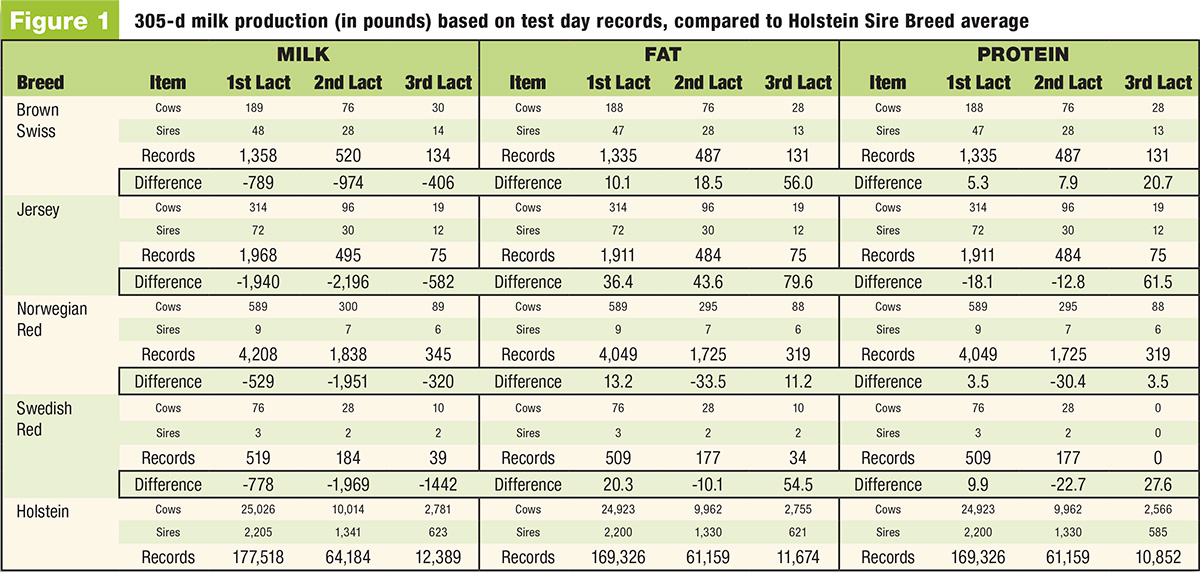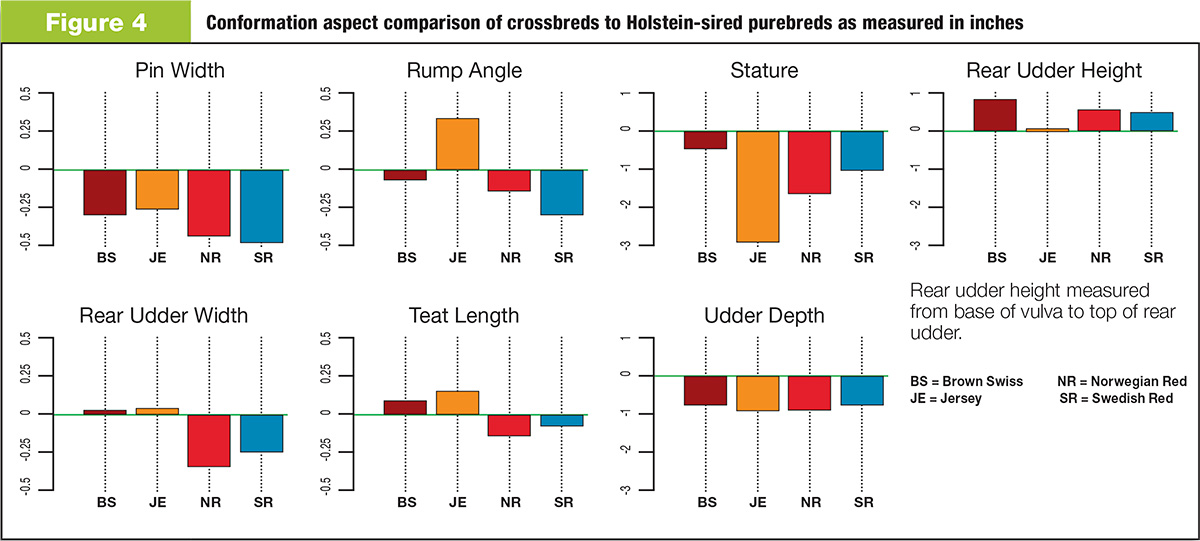Around the world and especially in North America, the purebred Holstein dairy cow is hard to beat for milk, fat and protein yields. The Holstein cow is also popular for commercial production of milk, particularly in fluid milk markets. The purebred Jersey cow has also earned a place in the sun in cheese-producing areas in Wisconsin, California and Texas.
So why would dairy farmers who keep purebreds for milk production ever be interested in crossing their cows to any other breed of sire?
There is more to dairying than just milking cows. Cows can get sick, fail to reproduce, have problems giving birth or have parts of their body deteriorate with age. Thus, the primary motivating reason for crossbreeding should be a matter of economics. A crossbred animal should either make more money or reduce expenses compared to purebreds.
A secondary reason is to decrease levels of inbreeding in purebreds, because high levels of inbreeding are associated with more reproduction and health issues. The current level of inbreeding in the Canadian Holstein population is 6 to 7 percent and climbing. Levels of inbreeding vary from herd to herd.
Inbreeding can be minimized through mating programs, by selecting sires that are less related to cows in your herd, if you are willing to make the matings that a computer program dictates to you. The selected sires may be some that you would like to avoid, or the cost of their semen may be too high.
Inbreeding reduces production, decreases reproductive abilities, increases susceptibility to diseases and can increase incidences of metabolic problems. Crossbreeding creates individual cows that are more robust than purebreds.
Our study
To determine if crossbreeding can make operations more efficient, we decided to look over some results of crossbreeding in Canada. All crossbred cows born in Canadian herds since 2005 were extracted from the databases at the Canadian Dairy Network, the organization that computes genetic ratings for sires and cows.
The crossbred animals were genetically compared to their purebred Holstein contemporaries within the same herds for production, reproduction, conformation, milking speed and milking temperament. The number of crossbred animals was low, less than 3 percent in those herds with crossbred animals.
The more numerous crossbreds were from Norwegian Red (NR), Jersey (JE), Brown Swiss (BS) and Swedish Red (SR) sires mated to Holstein cows. There were about 55,000 cows in 472 herds, or less depending on the trait analyzed. Swedish Red-sired crossbreds were separated from Ayrshire-sired crossbreds in the study, whereas an earlier study had grouped them together with Ayrshires because they are all registered in the Ayrshire herd book.
Details of analyses
This section contains some details of the analyses conducted. Unless you are interested in the details, please skip to the next section on results.
Data were analyzed using the same statistical models as used by the Canadian Dairy Network (CDN) in their genetic evaluations. That is, a multiple-trait test day model for production traits, but also milk, fat, protein and somatic cell scores were analyzed separately. Data included test day records from up to three lactations per cow and records were made from December 1, 2007, to January 21, 2011, in 398 herds.
Conformation traits were the measured traits (seven of them) and all seven were analyzed simultaneously in a multiple-trait system. Milking speed and milking temperament were also analyzed together with a similar model as for conformation.
These records were for first-lactation animals only, because older animals are not re-classified unless requested by the owner and only if the animals can be scored higher than in their first classification. Records were from 472 herds.
There were eight reproductive traits for heifers and eight for cows analyzed simultaneously in a 16-trait system, as in sire rankings by CDN. These include age at first service, non-return rate, number of services, first service to conception interval, calving to first service interval, gestation length, calving ease, stillbirths and calf size. Records were from September 2004 to January 2011 in 382 herds.
Estimated breeding values (EBVs) were calculated for every animal in the study for each trait. The average EBVs within breed of sire groups were calculated within traits. The average EBV for Holstein-sired cows (i.e., purebreds) were subtracted from the averages for the other breeds. Thus, the results show whether crossbreds by other breeds of sire had higher or lower values than purebred Holsteins.
The average EBVs of the dams of crossbreds and purebreds were also calculated within breed of sire groups to determine if the merit of the dams of crossbreds was different from dams of purebreds. The analyses showed that there were no significant differences between dam groups for any of the traits analyzed. Therefore, the comparisons between Holsteins and the different crossbreds are unbiased by dam selection.
Heterosis is typically estimated in crossbreeding trials. To calculate heterosis, the averages of the crossbred animals are compared to the averages of the two parental breeds (i.e. Holsteins and others). Unfortunately, the herds with crossbreds did not have any purebred Jersey, Brown Swiss, Norwegian Red or Swedish Red cows in them. Hence heterosis cannot be estimated from those data.
Heterosis does have an effect on performance, and therefore, the average EBV of crossbreds may be biased by heterosis (i.e., making the crossbreds look better). We are just asking if the crossbreds measured up to their Holstein herdmates. This must be kept in mind.
Heterosis effects are halved in the next generation if the crossbreds are mated back to one of the parent breeds. If one breeds the crossbreds to a third, or even a fourth breed, then heterosis is fully retained. If one chooses to rotate three or four breeds with Holsteins, the heterosis effects will not decline significantly.
Did we find significant differences between Holsteins and the crossbreds? Nearly all differences from this study were statistically significant. If the difference is more than two times the standard error of the estimate which is affected by the numbers of animals in the analyses, it is significant.
But some of the differences may not be of great practical importance. We will focus discussion on the most important differences.
The results: Production
Production traits are the major source of income for a dairy cow. We already stated that Holsteins were hard to beat, so how much production could be lost due to crossbreeding? This depends on the sires’ genetic potential of the other breeds mated to Holstein cows.
Norwegian Red and Swedish Red had fewer than 10 sires used in Canada, to date, and those sires were selected specifically to be of value to Canadian producers. Jersey and Brown Swiss sires were more numerous and represented a sample of all sires in those two breeds.
Figure 1 gives the results for milk yield, fat yield and protein yield. All of the crossbreds gave less milk yield than Holsteins, as expected, ranging from -529 lbs. to -1,940 lbs. in first lactation to -320 lbs. to -1,442 lbs. in third lactations, although numbers of animals and records in third lactation were low. This is a significant amount of milk.
Click here or on image at right to view it at full size in a new window.
By comparison, a 1 percent increase in inbreeding could result in a 200-pound decrease in production too, in the progeny from a purebred mating. Thus, an animal that is 7 percent inbred could have its production lowered by 1,400 lbs.
Fat and protein yields were greater for crossbreds than for Holsteins, except for protein yields in Jersey-sired crossbreds, and fat and protein yields in Norwegian Red and Swedish Red crossbreds in second lactations. Jersey crosses excelled in fat yield.
Practically speaking, the Holsteins were superior for milk but not for total milk solids production. In most milk markets, except those paying very little fat or protein differentials, the value of production was similar.
There were no practical differences in somatic cell scores between crossbreds and purebreds, although Jersey crosses were definitely higher than others for this indicator of mastitis.
Reproduction
Age at first service in heifers Figure 2a has a reasonable heritability for a reproductive trait. Brown Swiss-sired crossbreds were not different from Holstein purebreds for this trait, but Jersey and Norwegian Red were slightly older than Holsteins, while Swedish Red crossbreds were a day younger at first service.
Click here or on image at right to view it at full size in a new window.
Gestation lengths (2b) of Jersey, Norwegian Red and Swedish Red crossbreds, however, were 1 to 3 days shorter than for Holsteins, but the Brown Swiss crosses were 2.5 days longer as heifers in their first parity. As older cows, Norwegian Red crosses had 8.6 days shorter gestation length than Holsteins.
The increases in age at first service were counterbalanced by the shorter gestation lengths. Shorter gestations usually lead to easier calvings.
The ability of the lactating cow to become pregnant is evident in the following comparisons. Calving to first service intervals (2a) were shorter for crossbreds, except for Brown Swiss which was a half-day longer than Holstein purebreds. Thus, crossbreds started to be re-bred sooner after calving than Holstein purebreds by 2.5 to 4.25 days.
Brown Swiss, Jersey and Norwegian Red crossbreds had higher non-return rates (2c) than Holsteins as heifers, and all crosses were higher than Holsteins as cows by 2.9 to 9.4 percent. These advantages are huge, meaning crossbreds would have lower second-insemination-and-later costs than Holsteins.
The results indicate that crossbred females are more fertile than purebred Holsteins and should get back in calf sooner than Holsteins. Subsequently, the crossbreds would begin their next lactations sooner. Looking at number of services (2d), crossbreds had significantly lower number of services, but these differences were very small. The differences were bigger for lactating cows than heifers.
Another measure of fertility is the interval from first service to conception (2e). Crossbreds had significantly shorter intervals as heifers and cows (from -4 to -11 days) than Holstein purebreds, which agrees with the higher non-return rates.
Once pregnancy is achieved, the percentage of stillbirths (2f) becomes important. Crossbreds had a significantly lower percent of stillbirths than Holsteins by 1 to 7 percent as heifers and 1.5 percent lower as cows, because stillbirths are generally lower in older animals.
The lower stillbirth rates are partially attributed to smaller calf size (2g). Crossbreds had significantly smaller calves, but practically the differences were small. Calving ease (2h) was significantly lower for crossbreds. The crossbred cow seems to be more robust in reproduction and calving.
One important consequence is that plenty of replacements are produced in a well-managed crossbred herd, leaving greater scope for culling when replacements calve out and expanded sales opportunity for crossbred replacements.

Milking speed/milking temperament
Canadian dairy farmers who are on milk recording score their heifers on milking speed and temperament early in their first lactations. These data (Figure 3) show that there were no significant differences between crossbreds and purebreds for milking speed or milking temperament, except slightly slower milkers for Brown Swiss crosses and less desirable temperament ratings for Jersey crosses.
Neither of these traits have a huge economic impact on efficiency, but dealing with slow milkers or cows that are difficult to handle is not pleasant and some producers may be opposed to crossing for this reason. However, our results do not support this view.
Conformation
For many decades dairy farmers have been schooled to consider a show-winning cow as beautiful. These ideals do not necessarily apply in practical commercial dairy settings. One glaring example is the show ring and classification’s love of bigger, taller cows.
In contrast, commercial dairy operators want uniformly medium-sized cows. Unfortunately beauty includes the color of the hide, the marking patterns, black or dark red legs and hooves, etc. Naturally, crossbred animals can and do come in a variety of color combinations not always considered desirable to everyone, but these are minor considerations.
Hoof trimmers claim that dark-colored hooves are harder and wear longer than white hooves, yet Holstein breeders continue to desire white legs and hooves.
The important conformation aspects should be those that lead to longer herd life. Figure 4 includes comparisons of measured conformation traits; those not subjectively rated but objectively measured by a classifier in inches.
Click here or on image at right to view it at full size in a new window.
Holsteins were significantly taller in stature than all crosses and, as expected, the smaller stature of the crossbreds contributed to deeper udders, as measured from the floor of the udder to the point of the hock and lower rear udder attachments.
Additionally, crossbreds had narrower pins and narrower rear udder attachments, with Swiss and Jersey crosses being closer to Holsteins than the Scandinavian crosses in rear udder attachment width. Jersey crosses were flatter in their rumps with higher pins than other crosses and Holsteins.
Teat length and placement is of concern with robotic milkers, and the Jersey and Swiss crosses were slightly longer in teats than Holsteins, while the two Scandinavian crosses had shorter teats.
If these differences lead to crossbreds being removed from the herd sooner than purebreds, then this would be of major economic importance. However, these data simply spell out the differences and do not allow us to make any conclusions in this regard. Deeper, lower udders with narrower rear attachments will contribute towards culling.
Summary
Crossbreds in Canada produce less milk, and more fat and protein, than purebred Holsteins. Crossbreds reproduce more efficiently than Holsteins due to smaller calf size, with fewer calving problems and fewer stillbirths. These advantages in crossbreds will result in larger numbers of replacement heifers annually.
Crossbreds are not a problem for milking either in speed or temperament. They are small to medium in stature, a possible advantage, but deeper udders and narrower, lower rear udder attachments in some crosses compared to Holsteins could lead to earlier removal from the herd than Holsteins. There is no evidence to support this hypothesis yet.
We have not been able to examine the effects of crossbreeding on health traits or survival statistics. Do crossbred animals have fewer health problems? Certainly there is evidence that Norwegian Red crossbreds have greater immune responses when challenged, and this could lead to fewer health problems, but again there is no direct evidence yet.
First-generation crossbreds have zero inbreeding coefficients and will benefit from heterosis, particularly for reproduction and health traits. Thus, problems in purebreds due to inbreeding can be avoided or, at least, reduced by crossbreeding.
There are enough different purebreds in Canada that crossbred animals could be mated to a different breed of sire than either of its parents. This would maintain 100 percent of the heterosis as long as one chooses a new breed each generation, and would keep inbreeding at zero.
If breeds and sires are chosen carefully, the best characteristics of each breed could be incorporated into the crossbred individuals. Because there are a limited number of breeds available, a rotational system that uses Holstein every three to four generations and will keep production levels high is advised.
At this point, crossbreeding is recommended to dairy producers with significant reproduction and health problems, and/or high levels of inbreeding. Which breed or breeds should be used? That should be a personal choice, but choose sires within breeds that are in the 90th percentile or higher for your breeding goals or favorite index.
Researchers will eventually develop guidelines by analyzing the data that is accumulating on various breeding strategies in milk recording programs. Do your own experimentation with breeds and bulls. The crossbreds can always be culled if they do not live up to expectations, and there will be more scope for voluntary culling with crossbreeding. Keep good notes on your crossbreds and their contemporary purebreds, particularly with respect to calving, health, survival and reproduction.
References omitted due to space but are available upon request to editor@progressivedairy.com.












